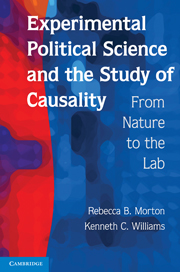Book contents
- Frontmatter
- Contents
- Acknowledgments
- I INTRODUCTION
- II EXPERIMENTAL REASONING ABOUT CAUSALITY
- III WHAT MAKES A GOOD EXPERIMENT?
- 7 Validity and Experimental Manipulations
- 8 Location, Artificiality, and Related Design Issues
- 9 Choosing Subjects
- 10 Subjects' Motivations
- IV ETHICS
- V CONCLUSION
- References
- Author Index
- Subject Index
8 - Location, Artificiality, and Related Design Issues
Published online by Cambridge University Press: 05 June 2012
- Frontmatter
- Contents
- Acknowledgments
- I INTRODUCTION
- II EXPERIMENTAL REASONING ABOUT CAUSALITY
- III WHAT MAKES A GOOD EXPERIMENT?
- 7 Validity and Experimental Manipulations
- 8 Location, Artificiality, and Related Design Issues
- 9 Choosing Subjects
- 10 Subjects' Motivations
- IV ETHICS
- V CONCLUSION
- References
- Author Index
- Subject Index
Summary
Experimental designs in political science vary along a number of dimensions – level of analysis, the location, whether a baseline treatment is used, how “artificial” the experimental environment appears, which subjects are recruited, how the subjects are motivated, and whether deception is used. In the next three chapters we investigate the first six of these dimensions. We discuss deception after our review of ethics in experimental research because in some cases deception is not only a design issue but also an ethical one. In this chapter we focus on the differences in levels of analysis, location in experimentation, baselines, and artificiality.
Levels of Analysis
The four lab experiments on information and voting discussed in Section 2.4.3 differ in the level of analysis. In Examples 2.4 and 2.5, the focus is on individual decision-making in how voters use information on candidate quality and react to video presentations of candidates and issues. In Examples 2.6 and 2.7, both individual and group decisions are considered because the experiments evaluate predictions from formal game-theoretic models with individual and group decisions as discussed in Chapter 6. Generally experiments on game-theoretic models use group decision-making designs, although not always. When subjects participate in a group decision-making situation, the experimenter gains data on both individual and group choices. This is an advantage in that both types of behavior can be studied and more interactive, simultaneous models of causality can be considered, as we discussed in Chapter 6.
- Type
- Chapter
- Information
- Experimental Political Science and the Study of CausalityFrom Nature to the Lab, pp. 277 - 321Publisher: Cambridge University PressPrint publication year: 2010



